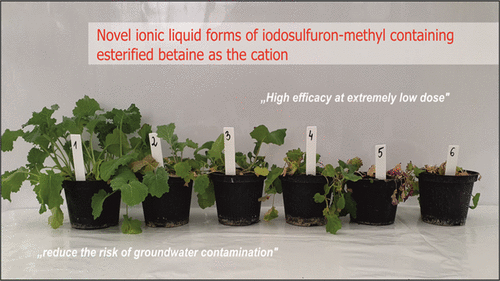当前位置:
X-MOL 学术
›
J. Agric. Food Chem.
›
论文详情
Our official English website, www.x-mol.net, welcomes your
feedback! (Note: you will need to create a separate account there.)
Iodosulfuron-Methyl-Based Herbicidal Ionic Liquids Comprising Alkyl Betainate Cation as Novel Active Ingredients with Reduced Environmental Impact and Excellent Efficacy
Journal of Agricultural and Food Chemistry ( IF 5.7 ) Pub Date : 2020-11-10 , DOI: 10.1021/acs.jafc.0c05850 Michał Niemczak 1 , Łukasz Sobiech 2 , Monika Grzanka 2
Journal of Agricultural and Food Chemistry ( IF 5.7 ) Pub Date : 2020-11-10 , DOI: 10.1021/acs.jafc.0c05850 Michał Niemczak 1 , Łukasz Sobiech 2 , Monika Grzanka 2
Affiliation

|
A new family of bio-based herbicidal ionic liquids (HILs) has been synthesized starting from the renewable resource glycine betaine (a derivative of natural amino acids). After esterification, the obtained alkyl betainate bromides containing straight alkyl chains varying from ethyl to octadecyl were combined with a herbicidal anion from the sulfonylurea group (iodosulfuron-methyl). The melting points of the iodosulfuron-methyl-based salts were in a range from 51 to 99 °C, which allows their classification as ionic liquids (ILs). In addition, the new HILs exhibited good affinity for polar and semipolar organic solvents, such as DMSO, methanol, acetonitrile, acetone, and chloroform, while the presence of bulky organic cations reduced their solubility in water. The synthesized products turned out to be stable during storage at 25 °C for over 6 months; however, at 75 °C they underwent fast, progressive degradation and released volatile byproducts. The values of the logarithm of the octanol–water partition coefficient of ILs with alkyls longer than hexyl occurred in the “safe zone” (between 0 and 3); hence, the risk of their migration into groundwater after application or the possibility of their bioaccumulation in the environment is lower in comparison with the currently available commercial form (iodosulfuron-methyl sodium salt). Greenhouse studies confirmed a very high herbicidal efficacy for the obtained salts toward tested plants of oilseed rape, indicating that they may become an attractive replacement for the currently available sulfonylurea-based formulations.
中文翻译:

碘磺隆基于甲基的除草离子液体,包含甜菜碱烷基酯阳离子作为新型活性成分,对环境的影响和功效均得到降低
从可再生资源甘氨酸甜菜碱(天然氨基酸的衍生物)开始,已经合成了新的生物基除草离子液体家族(HIL)。酯化后,将获得的含有从乙基到十八烷基变化的直链烷基链的烷基甜菜碱溴化物与来自磺酰脲基的除草阴离子(碘磺隆甲基)结合。碘磺隆甲基盐的熔点在51至99°C的范围内,这使其可以归类为离子液体(ILs)。此外,新型HIL对极性和半极性有机溶剂(例如DMSO,甲醇,乙腈,丙酮和氯仿)表现出良好的亲和力,而庞大的有机阳离子的存在则降低了它们在水中的溶解度。合成产物在25°C下保存6个月以上稳定;但是,在75°C下,它们会快速,逐步降解并释放出挥发性副产物。烷基长于己基的IL的辛醇-水分配系数的对数值出现在“安全区”(0到3)之间;因此,与目前市售形式(碘磺隆甲基丙烯酸钠)相比,施用后它们迁移到地下水中的风险或它们在环境中生物富集的可能性较低。温室研究证实,所获得的盐对油菜的受试植物具有很高的除草功效,表明它们可能成为目前可用的磺酰脲类制剂的诱人替代品。烷基长于己基的IL的辛醇-水分配系数的对数值出现在“安全区”(0到3)之间;因此,与目前市售形式(碘磺隆甲基丙烯酸钠)相比,施用后它们迁移到地下水中的风险或它们在环境中生物富集的可能性较低。温室研究证实,所获得的盐对油菜的受试植物具有很高的除草功效,表明它们可能成为目前可用的磺酰脲类制剂的诱人替代品。烷基长于己基的IL的辛醇-水分配系数的对数值出现在“安全区”(0到3)之间;因此,与目前市售形式(碘磺隆甲基丙烯酸钠)相比,施用后它们迁移到地下水中的风险或它们在环境中生物富集的可能性较低。温室研究证实,所获得的盐对油菜的受试植物具有很高的除草功效,表明它们可能成为目前可用的磺酰脲类制剂的诱人替代品。与目前市售形式(碘磺隆甲基丙烯酸钠)相比,施用后它们迁移到地下水中的风险或它们在环境中生物富集的可能性较低。温室研究证实,所获得的盐对油菜的受试植物具有很高的除草功效,表明它们可能成为目前可用的磺酰脲类制剂的诱人替代品。与目前市售形式(碘磺隆甲基丙烯酸钠)相比,施用后它们迁移到地下水中的风险或它们在环境中生物富集的可能性较低。温室研究证实,所获得的盐对油菜的受试植物具有很高的除草功效,表明它们可能成为目前可用的磺酰脲类制剂的诱人替代品。
更新日期:2020-11-25
中文翻译:

碘磺隆基于甲基的除草离子液体,包含甜菜碱烷基酯阳离子作为新型活性成分,对环境的影响和功效均得到降低
从可再生资源甘氨酸甜菜碱(天然氨基酸的衍生物)开始,已经合成了新的生物基除草离子液体家族(HIL)。酯化后,将获得的含有从乙基到十八烷基变化的直链烷基链的烷基甜菜碱溴化物与来自磺酰脲基的除草阴离子(碘磺隆甲基)结合。碘磺隆甲基盐的熔点在51至99°C的范围内,这使其可以归类为离子液体(ILs)。此外,新型HIL对极性和半极性有机溶剂(例如DMSO,甲醇,乙腈,丙酮和氯仿)表现出良好的亲和力,而庞大的有机阳离子的存在则降低了它们在水中的溶解度。合成产物在25°C下保存6个月以上稳定;但是,在75°C下,它们会快速,逐步降解并释放出挥发性副产物。烷基长于己基的IL的辛醇-水分配系数的对数值出现在“安全区”(0到3)之间;因此,与目前市售形式(碘磺隆甲基丙烯酸钠)相比,施用后它们迁移到地下水中的风险或它们在环境中生物富集的可能性较低。温室研究证实,所获得的盐对油菜的受试植物具有很高的除草功效,表明它们可能成为目前可用的磺酰脲类制剂的诱人替代品。烷基长于己基的IL的辛醇-水分配系数的对数值出现在“安全区”(0到3)之间;因此,与目前市售形式(碘磺隆甲基丙烯酸钠)相比,施用后它们迁移到地下水中的风险或它们在环境中生物富集的可能性较低。温室研究证实,所获得的盐对油菜的受试植物具有很高的除草功效,表明它们可能成为目前可用的磺酰脲类制剂的诱人替代品。烷基长于己基的IL的辛醇-水分配系数的对数值出现在“安全区”(0到3)之间;因此,与目前市售形式(碘磺隆甲基丙烯酸钠)相比,施用后它们迁移到地下水中的风险或它们在环境中生物富集的可能性较低。温室研究证实,所获得的盐对油菜的受试植物具有很高的除草功效,表明它们可能成为目前可用的磺酰脲类制剂的诱人替代品。与目前市售形式(碘磺隆甲基丙烯酸钠)相比,施用后它们迁移到地下水中的风险或它们在环境中生物富集的可能性较低。温室研究证实,所获得的盐对油菜的受试植物具有很高的除草功效,表明它们可能成为目前可用的磺酰脲类制剂的诱人替代品。与目前市售形式(碘磺隆甲基丙烯酸钠)相比,施用后它们迁移到地下水中的风险或它们在环境中生物富集的可能性较低。温室研究证实,所获得的盐对油菜的受试植物具有很高的除草功效,表明它们可能成为目前可用的磺酰脲类制剂的诱人替代品。






























 京公网安备 11010802027423号
京公网安备 11010802027423号